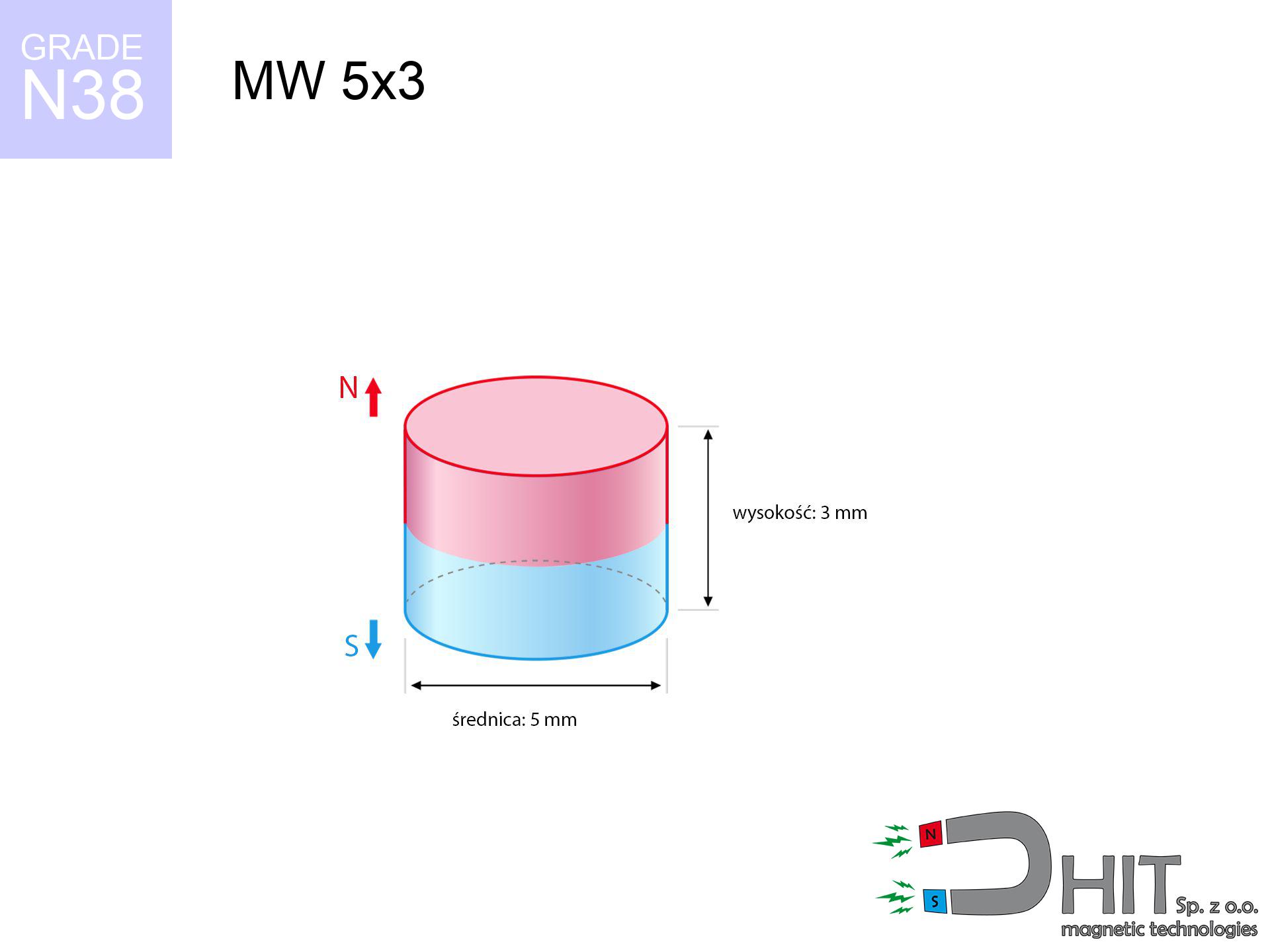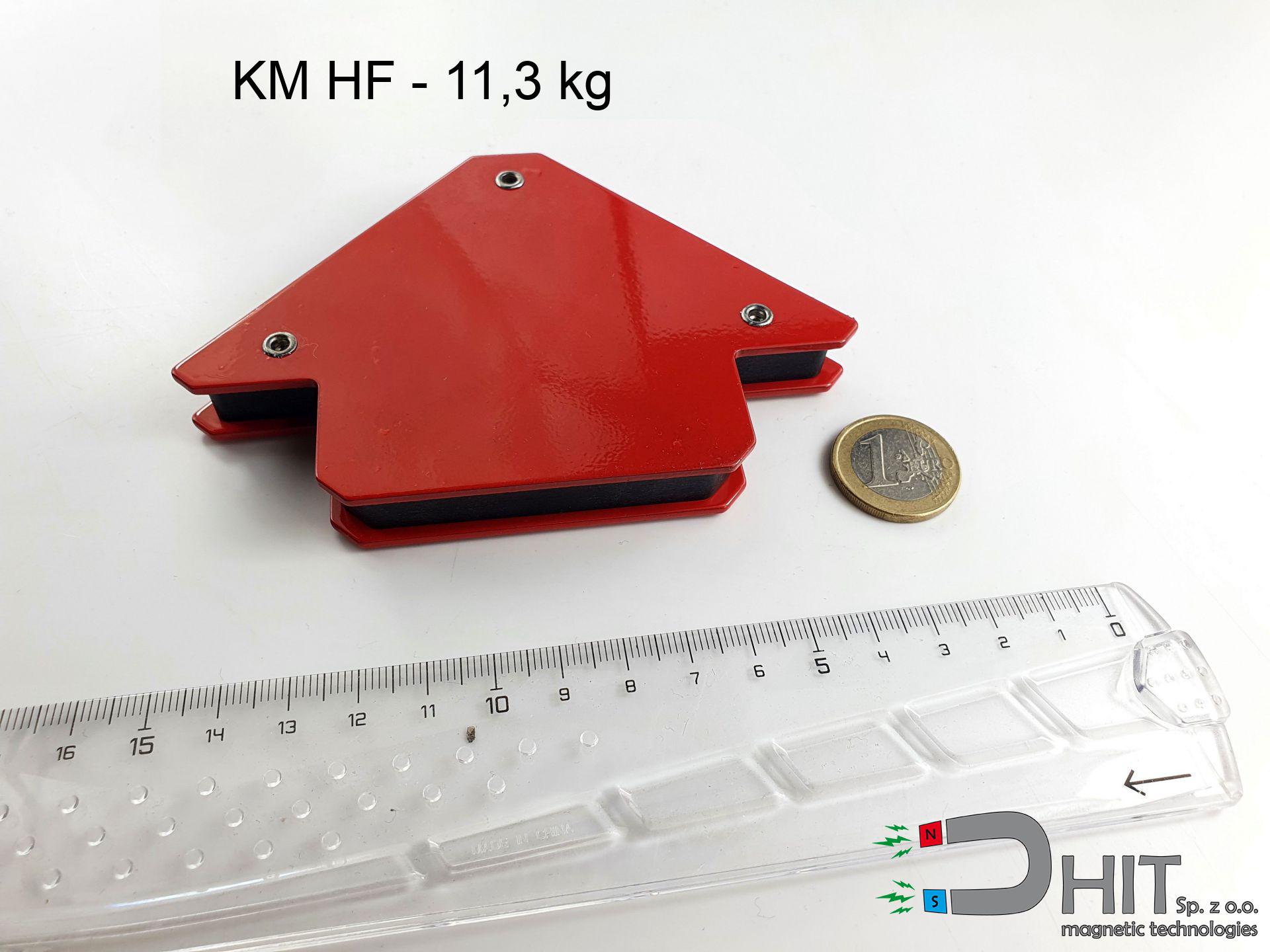MW 5x3 / N38 - cylindrical magnet
cylindrical magnet
Catalog no 010087
GTIN: 5906301810865
Diameter Ø
5 mm [±0,1 mm]
Height
3 mm [±0,1 mm]
Weight
0.44 g
Magnetization Direction
↑ axial
Load capacity
0.83 kg / 8.14 N
Magnetic Induction
475.16 mT
Coating
[NiCuNi] nickel
0.283 ZŁ with VAT / pcs + price for transport
0.230 ZŁ net + 23% VAT / pcs
bulk discounts:
Need more?Do you have questions?
Call us
+48 888 99 98 98
otherwise get in touch by means of
form
the contact section.
Parameters along with structure of magnets can be tested with our
online calculation tool.
Order by 14:00 and we’ll ship today!
Magnetic properties of material N38
Physical properties of sintered neodymium magnets Nd2Fe14B at 20°C
Shopping tips
Advantages and disadvantages of NdFeB magnets.
Besides their immense field intensity, neodymium magnets offer the following advantages:
- They have unchanged lifting capacity, and over around 10 years their attraction force decreases symbolically – ~1% (according to theory),
- They do not lose their magnetic properties even under close interference source,
- By covering with a smooth layer of nickel, the element presents an elegant look,
- Magnetic induction on the top side of the magnet turns out to be exceptional,
- Neodymium magnets are characterized by extremely high magnetic induction on the magnet surface and can work (depending on the shape) even at a temperature of 230°C or more...
- Thanks to the option of accurate forming and adaptation to custom projects, magnetic components can be created in a wide range of geometric configurations, which expands the range of possible applications,
- Universal use in modern technologies – they are utilized in mass storage devices, electric drive systems, diagnostic systems, as well as other advanced devices.
- Compactness – despite small sizes they provide effective action, making them ideal for precision applications
Disadvantages of neodymium magnets:
- They are fragile upon heavy impacts. To avoid cracks, it is worth protecting magnets using a steel holder. Such protection not only protects the magnet but also improves its resistance to damage
- Neodymium magnets lose their force under the influence of heating. As soon as 80°C is exceeded, many of them start losing their force. Therefore, we recommend our special magnets marked [AH], which maintain durability even at temperatures up to 230°C
- Due to the susceptibility of magnets to corrosion in a humid environment, we recommend using waterproof magnets made of rubber, plastic or other material resistant to moisture, when using outdoors
- We recommend a housing - magnetic holder, due to difficulties in producing nuts inside the magnet and complicated forms.
- Potential hazard resulting from small fragments of magnets pose a threat, in case of ingestion, which gains importance in the context of child safety. Furthermore, tiny parts of these magnets can be problematic in diagnostics medical after entering the body.
- Due to neodymium price, their price exceeds standard values,
Best holding force of the magnet in ideal parameters – what it depends on?
Information about lifting capacity was determined for ideal contact conditions, including:
- with the use of a sheet made of low-carbon steel, ensuring full magnetic saturation
- with a thickness minimum 10 mm
- with a surface perfectly flat
- without any insulating layer between the magnet and steel
- under vertical application of breakaway force (90-degree angle)
- in stable room temperature
Practical aspects of lifting capacity – factors
Holding efficiency is affected by specific conditions, mainly (from most important):
- Gap between surfaces – even a fraction of a millimeter of separation (caused e.g. by veneer or dirt) diminishes the pulling force, often by half at just 0.5 mm.
- Angle of force application – highest force is reached only during pulling at a 90° angle. The shear force of the magnet along the surface is typically many times lower (approx. 1/5 of the lifting capacity).
- Metal thickness – the thinner the sheet, the weaker the hold. Part of the magnetic field penetrates through instead of generating force.
- Material composition – not every steel attracts identically. High carbon content weaken the interaction with the magnet.
- Base smoothness – the smoother and more polished the surface, the better the adhesion and stronger the hold. Roughness creates an air distance.
- Thermal environment – heating the magnet causes a temporary drop of induction. It is worth remembering the maximum operating temperature for a given model.
* Lifting capacity was assessed using a polished steel plate of suitable thickness (min. 20 mm), under perpendicular pulling force, in contrast under shearing force the lifting capacity is smaller. Additionally, even a small distance {between} the magnet’s surface and the plate decreases the holding force.
Warnings
Electronic hazard
Equipment safety: Strong magnets can damage payment cards and delicate electronics (pacemakers, medical aids, timepieces).
Keep away from electronics
A strong magnetic field negatively affects the operation of magnetometers in smartphones and navigation systems. Do not bring magnets near a device to prevent breaking the sensors.
Immense force
Exercise caution. Neodymium magnets attract from a distance and snap with huge force, often faster than you can move away.
Power loss in heat
Monitor thermal conditions. Heating the magnet to high heat will permanently weaken its properties and strength.
Avoid contact if allergic
A percentage of the population suffer from a sensitization to Ni, which is the typical protective layer for NdFeB magnets. Frequent touching may cause a rash. It is best to use protective gloves.
Crushing force
Watch your fingers. Two large magnets will snap together immediately with a force of massive weight, crushing everything in their path. Exercise extreme caution!
Warning for heart patients
Life threat: Neodymium magnets can turn off heart devices and defibrillators. Stay away if you have medical devices.
Product not for children
Only for adults. Tiny parts pose a choking risk, leading to serious injuries. Store away from kids and pets.
Eye protection
Despite metallic appearance, neodymium is delicate and not impact-resistant. Avoid impacts, as the magnet may shatter into hazardous fragments.
Fire warning
Machining of neodymium magnets poses a fire hazard. Neodymium dust oxidizes rapidly with oxygen and is difficult to extinguish.
Danger!
Learn more about risks in the article: Magnet Safety Guide.





![UMGW 36x18x8 [M8] GW / N38 - magnetic holder internal thread UMGW 36x18x8 [M8] GW / N38 - magnetic holder internal thread](https://cdn3.dhit.pl/graphics/products/um-36x18x8-m8-gw-foj.jpg)
![UMGZ 16x13x5 [M4] GZ / N38 - magnetic holder external thread UMGZ 16x13x5 [M4] GZ / N38 - magnetic holder external thread](https://cdn3.dhit.pl/graphics/products/um-16x13x5-m4-gz-cor.jpg)


